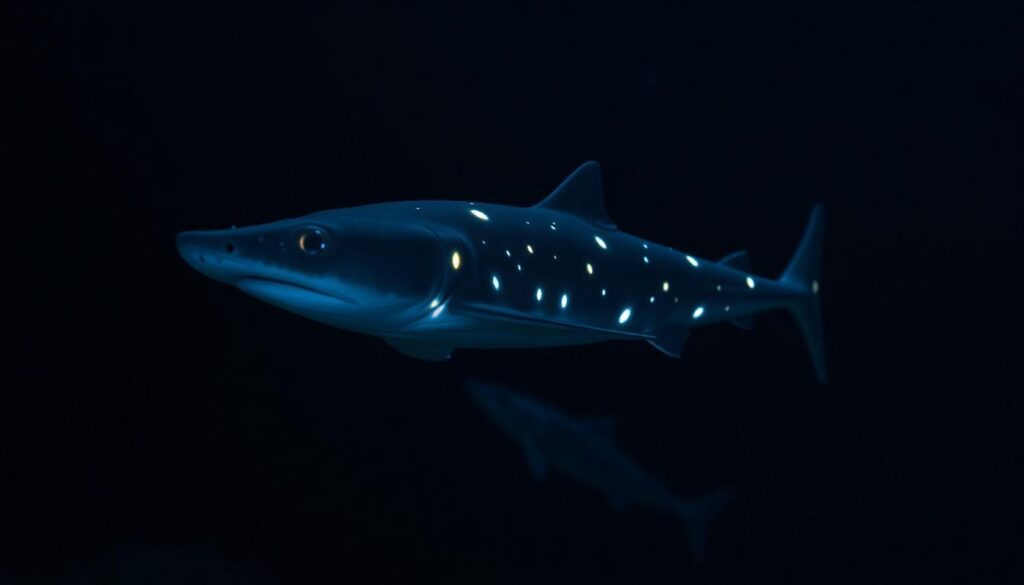When you think of sharks, images of massive predators often come to mind. But did you know there’s a tiny shark that might just surprise you? The dwarf lanternshark holds the title for the smallest shark in the world, measuring only about 8 inches long.
Overview of Sharks
Sharks belong to the class Chondrichthyes, characterized by their cartilaginous skeletons. Over 500 species of sharks exist, showcasing a diverse range of sizes, habitats, and behaviors. Sizes range from the diminutive dwarf lanternshark to the giant whale shark, which can exceed 40 feet in length. These essential marine animals play crucial roles in ocean ecosystems, often serving as apex predators.
Types of Sharks
Sharks are divided into several categories based on their feeding habits and ecological roles. Here’s a summary of the main types:
| Type of Shark | Feeding Habits | Examples |
|---|---|---|
| Filter Feeders | Filter plankton and small fish | Whale shark, Basking shark |
| Apex Predators | Hunt larger fish and marine mammals | Great white, Tiger shark |
| Bottom Feeders | Scavenge and feed on benthic organisms | Nurse shark, Angel shark |
| Opportunistic Feeders | Eat varying prey based on availability | Bull shark, Hammerhead shark |
Shark Habitats
Sharks inhabit various marine environments, from the shallow coastal waters to the depths of the ocean. Common habitats include:
- Coral Reefs: Home to many species, such as the reef shark, which thrive on abundant prey.
- Open Ocean: Species like the great white roam vast areas in search of food.
- Deep Sea: The dwarf lanternshark resides in deeper waters, showcasing unique adaptations to survive.
Shark Reproduction
Sharks exhibit different reproductive strategies. Some species lay eggs (oviparous), while others bear live young (viviparous). Here’s a breakdown:
| Reproductive Strategy | Description | Examples |
|---|---|---|
| Oviparous | Lay eggs in protective cases | Port Jackson shark |
| Viviparous | Give birth to live young | Great white, Bull shark |
| Ovoviviparous | Eggs hatch inside female | Common mackerel shark |
Sharks typically have low reproduction rates, with various species producing a small number of offspring every few years. These unique traits contribute to their vulnerability to overfishing and habitat loss. Understanding such aspects reveals more about sharks beyond their predatory reputation and highlights the importance of their conservation.
Characteristics of Small Sharks
Small sharks exhibit unique features that set them apart from their larger counterparts, including body size, shape, and habitat preferences.
Body Size and Shape
Small sharks, like the dwarf lanternshark, typically reach lengths of up to 8 inches. Their compact size allows them to inhabit specific environments, such as coral reefs and deep waters. Most small sharks share similar body shapes, which often include a slender silhouette and a pointed snout.
| Shark Species | Average Length (inches) | Body Shape |
|---|---|---|
| Dwarf Lanternshark | 8 | Slender |
| Pygmy Shark | 10 | Streamlined |
| Spined Pygmy Shark | 14 | Elongated |
| Cookiecutter Shark | 16 | Robust |
Habitat and Distribution
Small sharks thrive in diverse habitats, including shallow coastal waters, coral reefs, and pelagic zones. Some species prefer warmer waters, while others inhabit colder regions. The distribution of small sharks is global, with varying concentrations in different oceans, such as the Atlantic and Pacific.
| Shark Species | Preferred Habitat | Distribution Area |
|---|---|---|
| Dwarf Lanternshark | Deep sea | Atlantic Ocean |
| Pygmy Shark | Coral reefs | Pacific and Indian Oceans |
| Spined Pygmy Shark | Coastal waters | Western Atlantic |
| Cookiecutter Shark | Open ocean | Worldwide |
The Smallest Shark: A Detailed Look
The dwarf lanternshark stands out as the smallest shark species, reaching only about 8 inches in length. Understanding its unique traits and behaviors highlights its significance in the shark family.
Identification of the Dwarf Lanternshark
The dwarf lanternshark (Etmopterus perryi) exhibits distinct features that aid in its identification:
| Feature | Description |
|---|---|
| Length | Up to 8 inches (20 cm) |
| Color | Dark brown to black with luminescent spots |
| Body Shape | Slender, elongated body |
| Snout | Pointed snout |
| Habitat | Deep waters of the Caribbean and North Atlantic |
The combination of its small size and bioluminescent skin helps this shark camouflage in its dimly lit environment, making it harder for predators to spot it.
Behavioral Traits and Adaptations
The dwarf lanternshark exhibits various behaviors and adaptations essential for survival:
| Adaptation | Description |
|---|---|
| Bioluminescence | Produces light to evade predators |
| Feeding Habits | Primarily feeds on small fish and crustaceans |
| Reproductive Strategy | Oviparous; it lays eggs in protective cases |
| Social Behavior | Often found in schools, enhancing protection |
These traits enable the dwarf lanternshark to thrive in its habitat, balancing predator-prey dynamics in marine ecosystems.
Importance of the Smallest Shark in Ecosystems
The smallest shark, the dwarf lanternshark, plays a crucial role in marine ecosystems. It serves as both predator and prey, contributing to the balance of the food web.
Ecological Role
- Predator: Dwarf lanternsharks consume small fish and crustaceans, helping regulate populations of their prey. This predatory behavior maintains the health of the ecosystem.
- Prey: Dwarf lanternsharks are food for larger marine animals, including bigger shark species and fish. This position in the food chain supports various marine life and contributes to biodiversity.
Biodiversity
Maintaining small shark populations, like the dwarf lanternshark, enhances marine biodiversity. A diverse ecosystem supports resilience against environmental changes, allowing marine life to adapt to fluctuating conditions.
Habitat Preservation
Dwarf lanternsharks inhabit narrow oceanic niches. Preservation of coral reefs and other habitats where they thrive also benefits a variety of species, ensuring that ecosystems remain balanced and healthy.
| Habitat Type | Importance |
|---|---|
| Coral Reefs | Provides shelter and breeding grounds |
| Deep Sea | Hosts unique species and maintains diversity |
| Pelagic Zones | Supports migratory patterns and food webs |
Impact of Overfishing
Overfishing poses a significant threat to the small shark population. As these sharks face declining numbers, the disruption of their ecological roles could lead to unbalanced marine environments. Conservation efforts must focus on reducing bycatch and protecting habitats critical to their survival.
| Threat | Consequence |
|---|---|
| Overfishing | Decreased predator populations |
| Habitat Destruction | Loss of biodiversity and ecological imbalance |
| Climate Change | Alterations in distribution and behavior |
The ecological impacts of small sharks and their preservation efforts are vital for sustaining healthy marine ecosystems. Recognizing their importance leads to efficient conservation strategies needed for protecting marine life.
Conclusion
The dwarf lanternshark may be the smallest shark in the world but it plays a crucial role in marine ecosystems. Its unique adaptations and behaviors make it an intriguing species worth knowing about. By understanding the importance of small sharks like the dwarf lanternshark you can appreciate the delicate balance of ocean life.
Protecting these remarkable creatures and their habitats is essential for maintaining biodiversity. As you learn more about sharks consider how your actions can contribute to their conservation. Every effort counts in ensuring these tiny yet vital sharks continue to thrive in our oceans.
Frequently Asked Questions
What is a dwarf lanternshark?
The dwarf lanternshark is the smallest shark in the world, measuring about 8 inches long. It features a dark body with luminescent spots and is known for its bioluminescent skin, which helps it camouflage in dim waters.
How many species of sharks are there?
There are over 500 species of sharks classified within the class Chondrichthyes. They vary significantly in size, habitat, and behavior, ranging from the tiny dwarf lanternshark to the massive whale shark.
Where do sharks live?
Sharks inhabit various environments including coral reefs, the open ocean, and deep-sea habitats. Their distribution spans across different oceans and can vary based on the specific species.
What are the different feeding habits of sharks?
Sharks are categorized into several feeding types: filter feeders (like the whale shark), apex predators (such as the great white), bottom feeders (like the nurse shark), and opportunistic feeders (such as the bull shark).
How do sharks reproduce?
Sharks have different reproductive strategies, including oviparous (laying eggs), viviparous (giving live birth), and ovoviviparous (holding eggs within the body). Their low reproduction rates make many vulnerable to threats.
What adaptations do small sharks have?
Small sharks, such as the dwarf lanternshark, have unique features like slender bodies and pointed snouts. These adaptations help them thrive in their specific habitats and evade larger predators.
Why are small sharks ecologically important?
Small sharks, like the dwarf lanternshark, play a dual role as both predator and prey, maintaining the balance in marine ecosystems. Their presence supports biodiversity and resilience against environmental changes.
What threats do dwarf lanternsharks face?
Dwarf lanternsharks face significant threats from overfishing, habitat destruction, and climate change. These factors disrupt their ecological roles and jeopardize the health of marine environments.
What can be done to conserve dwarf lanternsharks?
Conservation efforts are crucial for protecting dwarf lanternsharks and their habitats. This includes advocating for sustainable fishing practices and preserving critical marine environments like coral reefs and deep sea areas.


